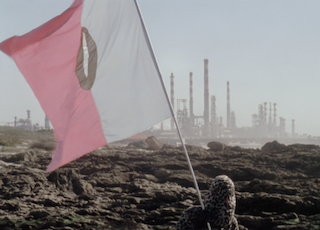In the work of Von Calhau!, a Portuguese duo comprising Marta Ângela and João Alves, a shamanistic imaginary steers an esoteric practice using film, print, music and performance as its instruments. The duo’s puckish theatricality and decidedly analogue vocabulary of 16mm, drawings, radiophonics and the body incants a libidinal atmosphere of ritual and carnival.
Oximoroboro offers a tour through Von Calhau!’s cosmogeny. A walking stick (Bengancho, 2015) juts out from the wall in the exhibition’s first room: clawing mechanically and blindly at the air in a piece of sculptural slapstick, it suggests both vaudevillian hook and symbolic crook. A leopard-print curtain-collage (AVESSO (cortina), 2011) conceals the entrance to the darkened second room, where totemic depictions of a mammoth and a dodo face each other, spotlit on opposing walls. Within each animal’s outline, an Arcimboldo-esque drawing depicts scenes of fantastical conflict. Smoke monsters with laser eyes emerge from a bird’s chimney-hat; priests are subsumed by warfare; a monkey raises a bow against a rain of daggers. The sign of the beast proliferates.
In another pitch-black space, a projected sequence of line drawings rotates across the inner surface of a cylinder (A Condução Cega, 2012–14), the images changing to a drumbeat soundtrack. Recalling the graphic trickery of Victorian inversion illusions, the drawings mutate in appearance as they twist across the screen. A clown face inverts to become a crusader’s ship. The vagina and anus in a pair of buttocks warp to become a winking face. It’s a joyous work, with a touch of the gravitas of Plato’s Cave; the drum infers ritual, the drawings prehistoric rock art, the illusions the bawdy fun of the fair.
Quadrologia Pentacónica (2010) and AVESSO (2011), both 16mm films transferred to digital, play in the next room. AVESSO sees Von Calhau! costumed in hooded fake-fur coveralls, linked by a guide rope-cum-umbilical cord, as one protagonist struggles to lead the other across a dramatic craggy landscape. A blind man-child in a foil cave appears allied to their progress and its macabre end. The pantomimic psychedelia of the four-part Quadrologia, meanwhile, sees the duo playing hopscotch in matching beards, a snake-puppet hypnotising a glittery group into another dimension, and the female Von Calhau! tempting the male Von Calhau! into putting a noose around his neck, before causing a landslide with her laser eyes. Oscillating between conflict and collaboration in elemental settings, the duo nod to the occultist camp of Alejandro Jodorowsky and Kenneth Anger.
A linear hang of Von Calhau!’s graphic screenprints fills another room – visual and verbal puns, posters for their films, ambigrams from A Condução Cega, alongside the labial-insignia flag featured in AVESSO – transmuting the duo’s slippery dream logic to two dimensions. In the show’s final film, Eulusionismo Antilusionistu (2015), a topless and leather-gloved female Von Calhau! whips her long hair back and forth, crushes a painted egg and toys with a €2 piece (whose eagle motif here reads as distinctly Third Reichian). A hand-drawn mouth explodes from the buttocks of a Greco-Roman sculpture of naked male wrestlers. Dressed in monochrome faux-fur, our protagonist raises a pair of knives, then a cymbal appears onscreen, triggering an actual cymbal in the exhibition’s anterior room to be hit by a mechanised drumstick – as if the film has conjured action in reality.
As terminology within his religion of Thelema, occultist prophet Aleister Crowley added a ‘k’ to ‘magic’ to differentiate between illusionistic trickery (magic) and mystical changes enforced by the power of will (magick). Oximoroboro situates the work of Von Calhau! – similarly lovers of symbolic word play – in the space between these poles: seeking magickal transcendence while revelling in stagecraft.
Culturgest, Lisbon 24 October – 23 December
This article first appeared in the January & February 2016 issue of ArtReview.
